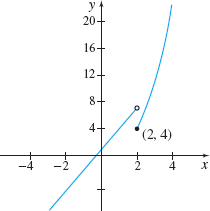EXAMPLE 5Finding a Limit
Find lim, if it exists, if f( x) =\left\{ \begin{array}{l@{\qquad}ll} 3x+1 & \hbox{if }\quad x\lt 2 \\[3pt] 2x( x-1) & \hbox{if }\quad x\geq 2 \end{array} \right.

Solution Since the rule for f changes at 2, we need to find the one-sided limits of f as x approaches 2.
For x\lt 2, we use the left-hand limit. \begin{equation*} \lim\limits_{x\rightarrow 2^{-}}f(x) =\lim\limits_{x\rightarrow 2^{-}}(3x+1) =\lim\limits_{x\rightarrow 2^{-}}(3x) +\lim\limits_{x\rightarrow 2^{-}}1=3\!\lim\limits_{x\rightarrow 2^{-}}x+1=3(2) +1=7 \end{equation*}
For x>2, we use the right-hand limit. \begin{eqnarray*} \lim\limits_{x\rightarrow 2^{+}}f(x) &=&\lim\limits_{x\rightarrow 2^{+}}[ 2x(x-1)] =\lim\limits_{x\rightarrow 2^{+}}(2x) \cdot \lim\limits_{x\rightarrow 2^{+}}(x-1)\\[4pt] &=&2\lim\limits_{x\rightarrow 2^{+}}x\cdot \Big[ \lim\limits_{x\rightarrow 2^{+}}x-\lim\limits_{x\rightarrow 2^{+}}1\Big] =2\cdot 2\,[2-1] =4 \end{eqnarray*}
Since \lim\limits_{x\rightarrow 2^{-}}f(x) =7\neq \lim\limits_{x\rightarrow 2^{+}}f(x) =4, \lim\limits_{x \rightarrow 2}f(x) does not exist.